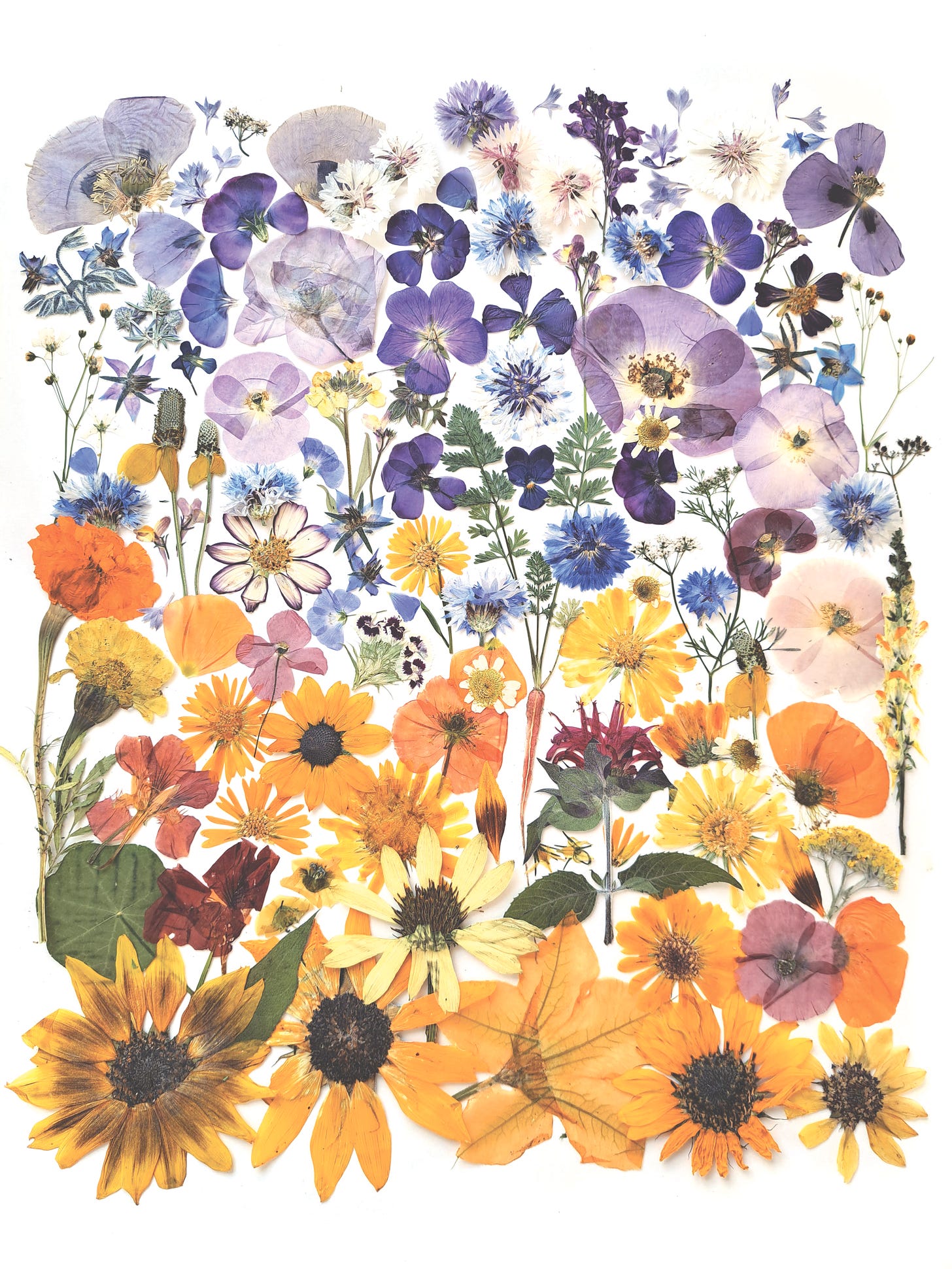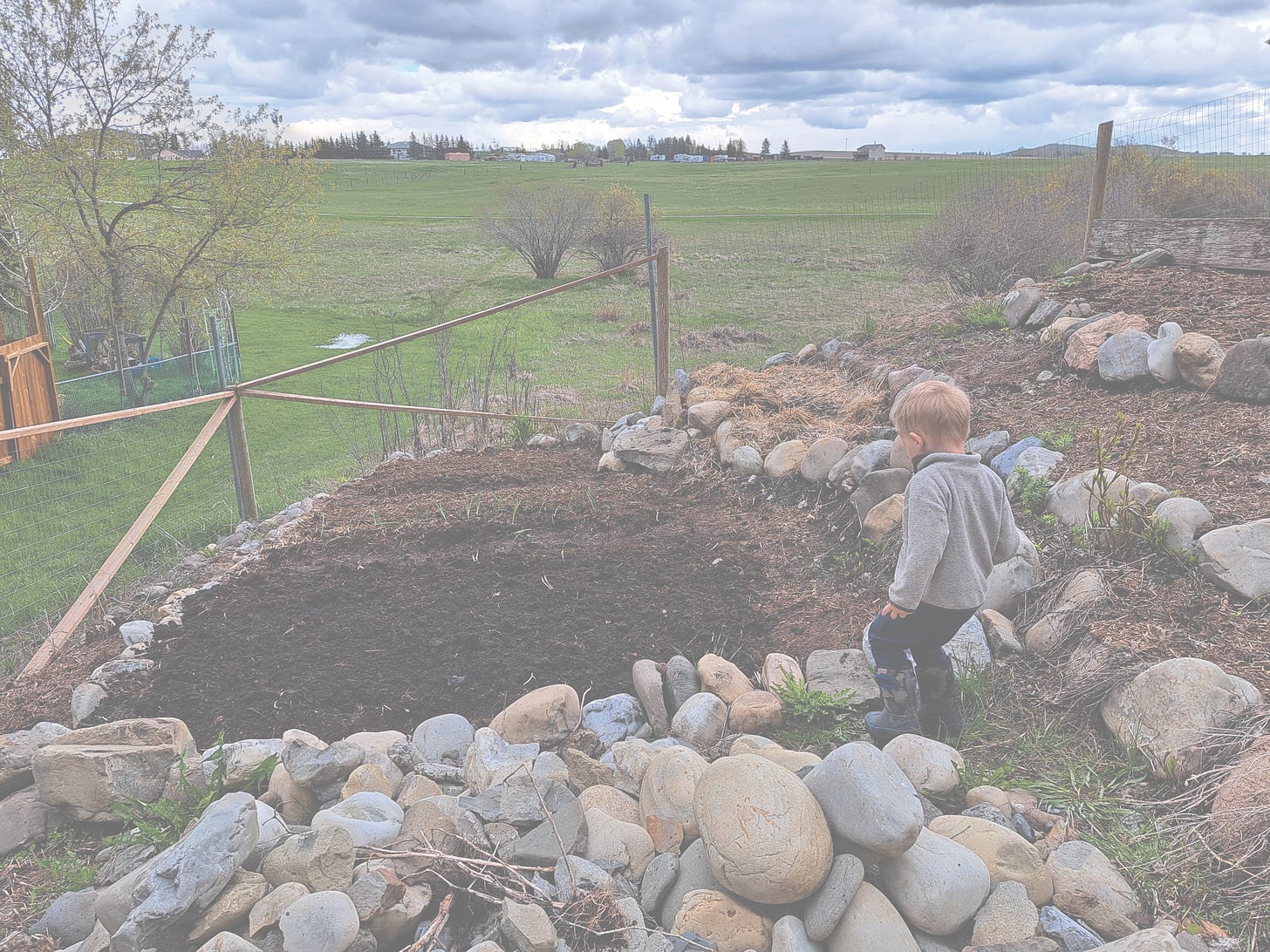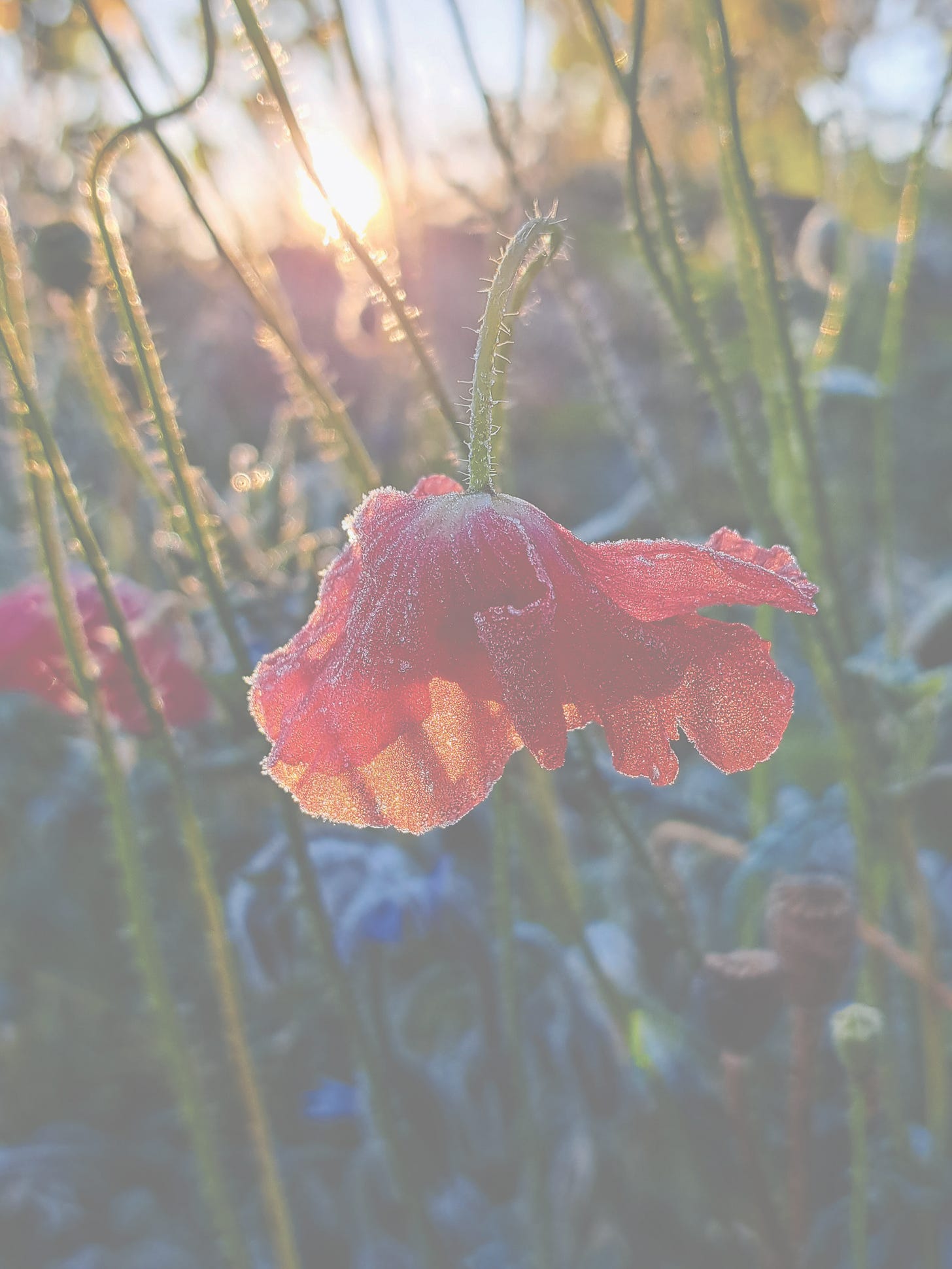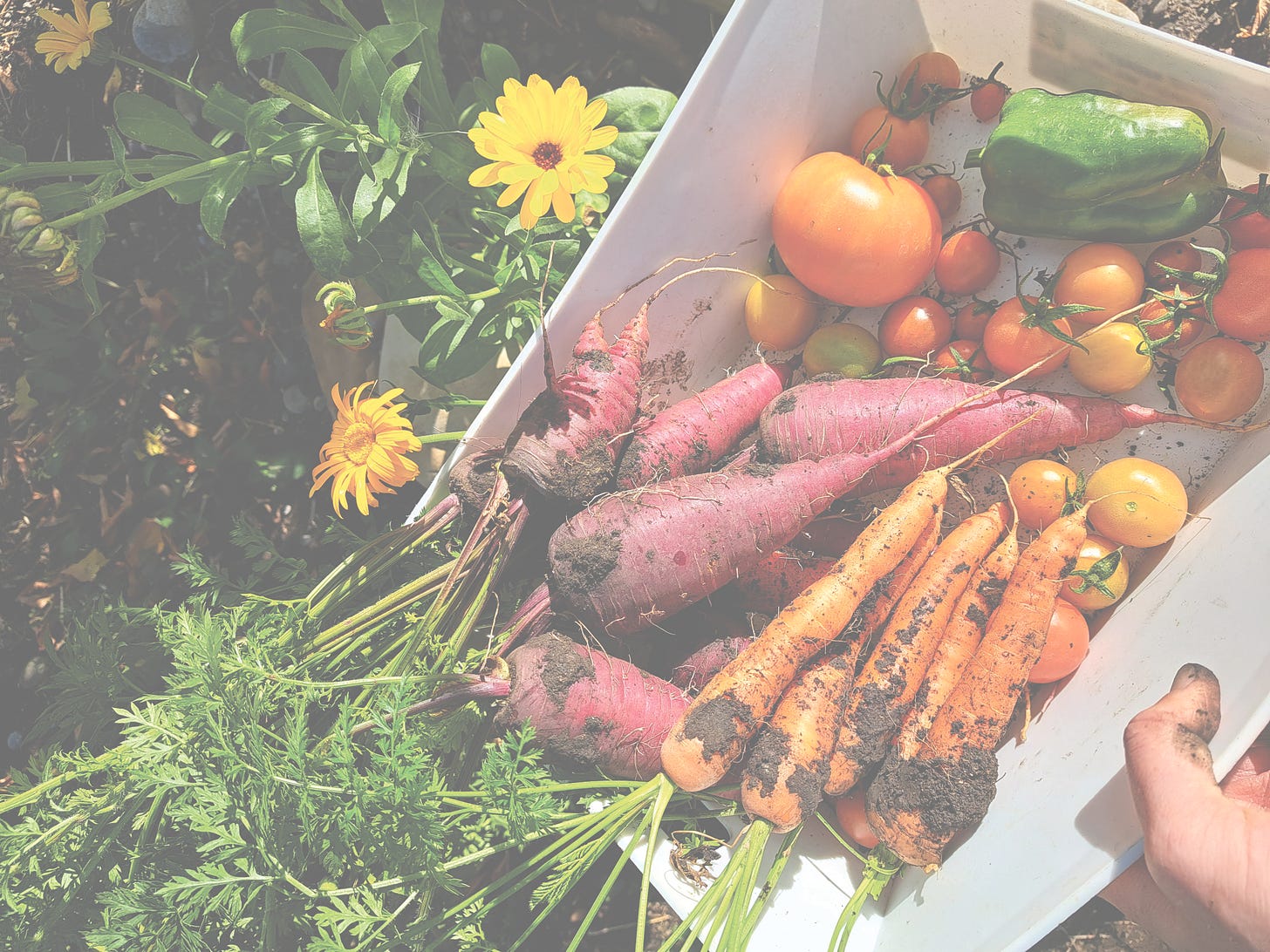Extreme Gardening
Writer Sylvia Dekker's backyard garden becomes her own Rocky Mountain wilderness
This article originally appeared as a feature in the Spring Issue of our newsprint magazine eponymously titled The Westrn. Get a print copy shipped from The Westrn Store for just $15.
Author: Sylvia Dekker
Summer 2025 Print Issue (Vol II)
I stumble, catching myself before eating dirt. It’s still dark, the trail only illuminated by the weak beam of my husband’s headlamp a few paces ahead. We crunch ever upwards, steps buoyant without our toddler and his various needs on our backs. My husband sings ‘Land of the Silver Birch’, a heads up for grizzlies. The sky lightens to a smudge of dusty purple. A glassy blue-green lake emerges from the trees, opening up the view of our objective.
That’s one big, faraway rock.
Rocks. So many rocks. I might as well be in the mountains.
I chuck a hefty one into the growing pile and eyeball the steep slope of my new yard, wondering how long it’ll take to turn a chunk of it into a productive garden. My back says forever. My arms agree with my back. I heave another and it splinters with a sharp crack. I slowly free patches of the steep ground from their burdens, the dirt underneath compacted into shiny brown pits.
It’s already May, and my Zone 3 growing season is a blink between frozen nostrils. Any frost-tolerant vegetables should have been seeded yesterday. A lifetime ago, my soil science professor insisted dirt was a derogatory term for the living soils we studied, best used to describe what my kids now track indoors. I snort as I try to stab a hole for a pea seed with my finger. Even he’d agree this was pure dirt: no structure, no porosity, no life.
I plant spinach, lettuce, beets and carrots in small sections in it anyway. My shovel scrapes into the dirt, sending shivers up my spine, and I know that when I pull carrots this fall they will be shaped by the small rocks buried beneath the surface.
The rock pile threatens to swallow half of my back yard. I pivot from chucking and begin intentionally placing heavy, colorful stones, creating rounded terraces. A garden of sorts emerges. Rock-defined beds remind me of a wander in the woods, hunting for shed antlers or little pink orchids.
I hate the brown bare dirt in the weeks post-seeding. It’s ugly and barren and stale. I anxiously wait for green shoots to emerge. When I irrigate, the water carves rivulets into the slope that disappear at the bottom of the garden.
I can hear the waterfall before I can see it. The noise propels me up the dirt path that winds through scrubby spruces and purple asters. The peaks are awash with warm, welcoming colours, but I’ve done this before and know the invitation comes with an asterisk of challenge.
Neither my husband nor I can budge one giant square purple rock, so it finds a permanent home in one of the bottom beds. I perch on it to survey this alien space I call a garden.
Why am I even bothering? Thistles, prickly lettuce and dandelions seem to sprout through the dirt every time I turn my back to move another rock. But it also seems like every time my feet and hands touch the ground, I become more attached to it. Creating a garden helps me hold nature close and keeps it relevant during this life stage when I’m more bound to home. I must work with its challenges to reap its gifts. The slow processes of planting, tending, and — if I’m lucky — finally harvesting is both rooting and grounding, literally and metaphorically.
My legs burn, my lungs burn, and I question why I’m doing this to myself, as I climb a long and steep slope. Sunshine spills over the rocks and juniper above us, wafting down summer-in-high-alpine warmth and spice. A bumblebee drones in wide circles around me. I begin trudging again, trying to disassociate from the discomfort and instead focus on my surroundings.
In the garden, I'm more than a passive observer; I’m an active being, spooking both deer and grouse. I manipulate things to be productive, plant things I like, and weed out stubborn grass. Here, I make hopeful decisions and changes that will positively impact the ecosystem surrounding my home.
The first year of vegetables was hardly productive. Nutrients, water, time and knowledge were in deficit. Winter lurked. It hailed often. Mule deer in velvet bounded over the fence, helping themselves to salads of spinach, strawberry leaves, and peas. My fingers bled after digging carrots in the fall. Like a false summit, the tops beckoned, luscious and tall. But the orange roots came out of the sticky dirt stunted, distorted, and deeply disappointing.
I tell myself roots in the ground is enough. Ground cover adds nutrients and organic matter. Roots break through the tough ground. My agricultural background informs this, but I still blink back tears of frustration and exhaustion.
I’m in this for the long haul. Life billows with the speed, enormity, and beauty of summer storm clouds. When my body — growing twin babies — tells me I can no longer carry my son up a mountain slope, my wanderlust gnaws. Nature beckons with all its little beauties and big adventures. I crave sucking lungfuls of fresh pine-laced air, leg-quivering exercise, and seeking little wild discoveries.
We emerge into a sun-drenched sea of color, and my jaw hits the trail. I pull out my phone and lag behind, trying to capture every wildflower and the vistas they frame. This is why I hike, I think. I make the most of the easy flat-packed dirt path. I soak in summer alpine bliss.
After the twins are born, a helpful friend pulls a chair up to the topmost rock wall and sits with her feet propped up. She reads a book, facing my wild, messy garden. In my postpartum fog, the fact that this cultivated space helps her relax blows my mind; I begin to intentionally use my garden as a place to recharge. I delight in watching frantic native bees on blooming dill and calendula. I drool over the last evening rays glowing through poppy petals. I take my camera out and capture visiting butterflies, tiny raptors, and gold finches.
This is why I garden. It’s not only for the veggies; I’m a flower girl at heart. A steep section becomes a chaos garden. I throw in several more packets of annual and perennial wildflower seeds –- pretty things I find along the trail like lupine and columbine –- and only occasionally pull grass and thistles. I dedicate an entire row running the length of the rough rocky rectangle to helpful plants like nasturtiums, marigolds, cosmos, borage, and monarda.
Eventually it blooms every color, from pink crinkly poppies to blue flax, buzzing with life that radiates out into the rest of the garden. The combination of blooms invites nature in for a feast. Hoverfly adults sip cilantro nectar; their larvae chow down on pest insects. Songbirds nibble sunflower seeds pollinated by mammoth fuzzy bumblebees.
The garden becomes my wilderness when the backcountry is out of reach. No one else knows where the paths really are. The bed shapes change every year. Rocks indicate random rows of zinnias, cornflowers, and sage. They mark the ends of a freshly seeded row of beans, ring watermelons that will never produce ripe fruit, and show where cabbages were before they’re chewed to smithereens by flea beetles.
Volunteer clovers and vetches pull nitrogen from the atmosphere, injecting the vital macronutrient into the soil. I leave them growing between the leeks that my kids helped plant. The rows are, at best, haphazard. The dirt needs more help, so we spread a dump trailer load of alfalfa hay, straw bedding, and goat manure over the entire garden. I can almost hear dirt becoming soil.
Standing with dirt-stained hands on my hips, I look over my messy, frustrating, yet fulfilling domain. I feel some hope and pride grow with it. This garden is now cultivating me, refusing to let me give up, teaching me patience. I wonder if, on this shady north-facing slope where slush still falls from the sky at the end of June, I’m finally figuring out Zone 3 gardening. From a fence post, a magpie chuckles in my direction.
A Swainson’s Thrush flutes ascending notes from the treetops below. It’s all open alpine meadow ahead. Blooms vibrate with insects among tumbles of rock. The perfect, lush, living garden conceals the harsh conditions it faces. We climb among clusters of deep pink paintbrush and rocky cliffs. We refill our water bottles in the crystal-cold stream and look back at the trail dropping down behind us, the shrinking lake, and the shades of blue peaks beyond. We’ve come a long way but a mountain still waits. The trail disappears in a boulder field. We snake from cairn to cairn. My hiking boots make mountain music with each step.
I slide around in Walmart crocs, moving rocks and pulling thistles. Strangely, this gardening thing is beginning to feel more intimate than wandering through the forest and sitting at the base of an old whitebark pine. Here, I invite the native species living nearby to pollinate, control pests, and share the foods we will eat. The relationships I’m developing with the forces are deep and appreciative. Among swaying herbs buzzing with happy insects, a kinship emerges.
Year by year, I start seeds in my basement each February, put final seeds into the soil in June, and thick frost sparkles on adult plants by September. I impatiently wait for snow to melt off the shady slope and for avalanche danger to abate in the mountains. I am as much at the mercy of weather whims at home as I am out there. I set up a cheap cone greenhouse to extend the season for my tomatoes and peppers so that maybe, maybe, they’ll produce fruit before the season ends. I practice crop rotation, trying to outsmart the flea beetles, slugs, and carrot weevils. I research companion planting. This turns my garden into a community of mutually beneficial, resilient, productive plants that rely and depend on one another.
My backyard’s biodiversity is thrilling, with some species more welcome than others. A ground beetle — shining like a black opal — burrows away. Rusty centipedes scurry as I dig potatoes. Spittle bugs and slugs slide around on slick stems. A tiny sweat bee lands on my arm, its forehead streaked with a stripe of Cheeto-dust pollen. Lacewings, lady bugs, crab spiders, caterpillars, butterflies and moths live, grow, and reproduce here.
We pause for a breather in a mountain goat’s dirt bed and examine his tracks. A ptarmigan waddles in the rocks above, cocking a beady eye at us. I relish every moment in the presence of wild things. It’s t draws me to the backcountry.
The day heats up, the slope gets steeper. We kick-step up a snow patch. Beads of snow shower down, sprinkling my sweaty, sunburnt skin. I get into the flow of uphill motion, soak in the pure silence of a day off from motherhood. A marmot whistles.
A dog barks at me from across the grassy alley when I hop into my strawberry bed to weed around runners while my kids nap. Detailed tending is for when patience is plentiful; today is not one of those days. I grab a hoe and release frustrated energy into the ground with each blow. I get into a flow, breathing in the scent of dirt becoming soil, pausing to crack my back. My hands turn brown — freckles on one side, dirt on my palms. Weed juice stains my thumbs green.
In the spirit of letting nature take the wheel, I let plants set seed at will. The next season, I weed around volunteer chamomile, sunflowers, spinach, flax, poppies, cosmos, and onions in my potato bed while three little kids pull sleds filled with small garden rocks in the lawn above.
I romanticize my every day now that the backcountry is that much harder to get to, and motherhood weighs like a warm but heavy blanket. It’s working. We draw chalk smiley faces on the rocks at the top of the garden. The kids gobble any and all fruit they see, ripe or not. I brush a mosquito off my youngest’s forehead. He grins up at me with strawberry-stained teeth.
Panting upwards, I suck a mosquito into my throat. I cough, spit it into the rocks, and take the last few steps to the pass. A sea of glaciers and peaks opens up. I forget about my burning calves. Dark rock towers on both sides of us, framing a sunlit icefield. A lake drops off the edge of a cliff. Blue peaks stretch out and melt into the sky.
Adventure lives as much on my steep garden slopes as it does on those made of tinkling shale. Even when the beets are tiny, the spinach bolts too soon, and the spaghetti squash is still green at frost, the garden satiates my hunger for the outdoors.
I embrace the chaos, welcome in both nature and little feet. I battle short seasons, summer hail, limited water, and challenging slopes. There are plenty of moments I don't enjoy about this place, like tweezing thistle spines out of my fingertips or picking slugs off my garlic. Overall, though, I’m harvesting a net positive: healthy food, hands-on work, productive procrastination, and straight-up beauty beyond my doors.
My legs shake with exhaustion. I enjoy this, I try to convince myself, as I watch a stone tumble away from my perch on the once big and faraway rock. It’s lifeless up here. My eyes wander to the blooming green below, but I drag them higher to where mountain and sky meet. It looks straight up, and I’m no mountain goat. I summon stubbornness. I put one foot above the other.
If I know anything about relationships, they’re a two-way street. I claim to be a nature lover, but treading trails, sharing my love for it, and encouraging others to get out there isn’t enough. In my garden, I give back in small but meaningful ways, all the while enjoying many of the things I love about being in the wilderness. The spicy smells, the discoveries, the aesthetics, and the rawness.
There is no more up. Everything in view is below and beyond. I barely feel the last few steps to where my husband flips through the summit box log. We relax on the peak for a long time, pointing out luminous crevasses, silty green lakes, and gravel raked into flowing lines by a long-gone glacier. I ignore the fact that we are only halfway done. As we begin the painful downclimb, I set my sights on wandering the level and colourful meadow again.
A butterfly flits under my hose shower in a flutter of dusty blue, and I spy a spiny juvenile ladybug patrolling a basil leaf. Every time I step foot in this garden, I connect with the wild. It’s a feeling I only get in the backcountry when I cut a morel, trace the rough pads of an old black bear print, or nibble a wild rose petal. As I head indoors to finish dinner with a bundle of fresh green onions and spinach, grown by these hands and this annual effort, I palm and scarf a few ripe raspberries the kids missed.
Between a hip-screamer of a downward step, I spy plump violet huckleberries dripping off green bushes along the trail. The berries pop, warm and sweet, in my mouth. My steps become lighter, halted, wandering. The rest of the downhill is a blur of colour, of satisfaction of birdsong.
I love it here.
I love it here.
Sylvia Dekker is based in a small town in the Albertan Rocky Mountain foothills. Fresh air, wild places, and the life they contain — from the smallest wonder to the vastest detail — are the heartbeats of her family and pen. She shares her love of exploring nature with her husband, toddler, and twin babies. Find her @syl.dekker and www.sylviadekker.com.









